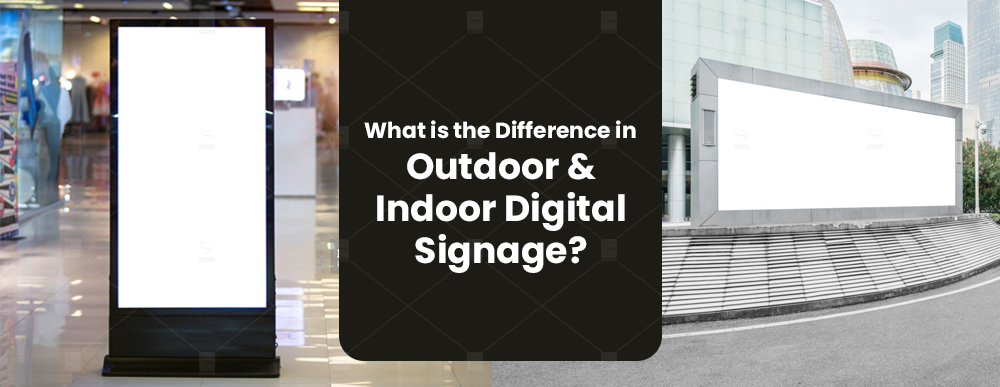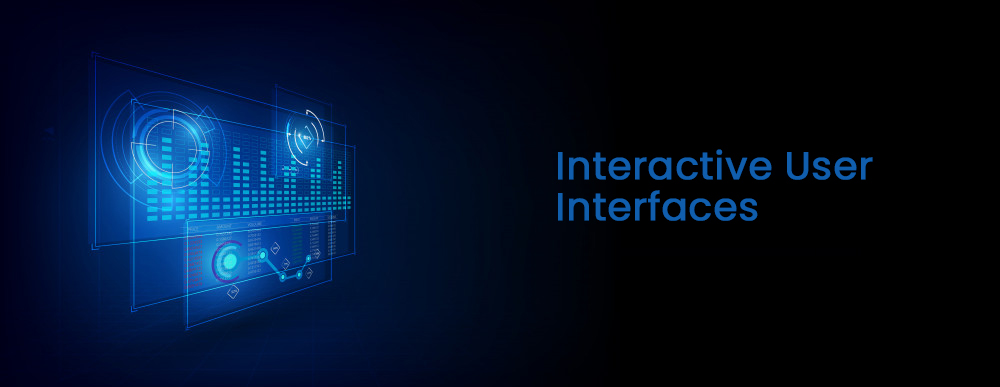If you are a business or an organization operating in Dubai, UAE and looking for brand awareness or promotional advertisements, digital signage is an excellent tool to help you with your marketing objectives. Here it is worth noting that both indoor and outdoor digital signage have gained huge popularity in the past few years not only in UAE or GCC but all across the world. The market researcher is predicting that the digital signage market could grow up to 30% or even more in the coming five years, and that is huge.
As we all know the year 2021 is the year of the Expo, which will attract millions of visitors and thousands of investor from all across the world to Dubai and UAE. It is always wise to prepare beforehand to get a competitive edge. Even before the event for the past few years, the local market is rapidly adopting digital signage technology and we are witnessing new indoor and outdoor screens popping up everywhere.

Both the indoor and outdoor signage displays are different from others. The business and organizations need to understand this difference very well before investing in technology. Here are the major differences between indoor signage and outdoor signage:
Marketing Goals and Audience

Each advertisement campaign has a goal. For the digital signage campaign, there must be a marketing goal. First of all, you should decide what are your marketing goals of utilizing digital signage? Then you will be able to determine which type of digital signage can help you achieve your goals. For example, when you are running an advert on outdoor signage, you are targeting a broader spectrum of audience. Whoever is passing by can view the ad and can be a potential prospect. Hence a completely different approach is required, the advert should be created with those audiences in mind. The content of the advert, the size of the digital signage and everything else should be prepared accordingly to make the advert more attractive for your targeted audience.
For the indoor signage, the audience is completely different. The indoor signage is mostly placed inside the premises or at least in near proximity. If the digital signage is installed indoors inside the business’s premises then it means that you have already attracted a prospect who is already at your showroom or store or whatever. Now the information you should display in the advert should be different which could encourage your customers to make an instant decision. For example a sale offer or discounted price list of a particular item, service or product. Now the approach is totally different from that of the outdoor signage.
See Also: How to Choose Digital Signage in Dubai, UAE
Business can have multiple indoor signage on different strategic positions. For example, you are in a store to purchase a mobile phone, the store hosts a wide range of electronics and gadgets. In the mobile phone section, you can have indoor signage showing the discounted price of a branded headphone. This will be very encouraging for a customer to make an instant decision to buy the headphones along with their new smartphone.
Both indoor signage and outdoor signage have different audiences and a completely different communication approach is needed to get the full advantage of the digital signage. Digital signage and video walls are a very effective type of advertisements, they always interest the passing by people. The flashy content and bright lights always attract people towards them. If used effectively with appropriate targeted audiences in mind the digital signage and video walls could do wonders to boost your sales and conversions.
Interactive User Interfaces

The interactive user interface is available for both indoor signage and outdoor signage. Although for the outdoor signage and video walls the interactive features are limited to certain applications only. For example, the billboards do not offer touch screens and interactive interface as no one is expected to climb to the top of a pole or side of a building to interact with them. However, for floor standing or wall-mounted indoor and outdoor digital signage, interactive user interfaces can be provided. For the video walls, as they are also very huge no matter used indoor or outdoor the interactive features are not so effective, except only in a certain environment with very limited applications.
The interactive user interfaces can help customers further explore your products and services via a touch screen. The adverts and information provided on interactive digital signage also vary from case to case. Each application is different from the other and each objective of the campaign is also different. The interactive user interface provides more chances of getting instant leads and conversions. It is more effective and efficient to have an interactive feature with indoor signage rather than outdoor signage. As the indoor customers and prospects are already on the next stage of conversions so the interactivity can definitely impact their decisions a lot.
See Also: Why Interactive Self-service Kiosks are the Ultimate Customer Experience Transformation Tool?
Hardware

The hardware of both indoor and outdoor signage is completely different in all ways. The outdoor environment and indoor environment both are totally different in terms of natural lighting hence require a different level of display brightness. That is the difference that can easily be recognized by the customers and visitors. As the sizes of digital signage range from as small as that of an iPad and as big as that of a billboard, the hardware and technologies are also different.
Indoor Signage Display
For indoor signage, the screens are usually used of very high definition and higher resolutions. As the customers and visitors can view them from very close. The indoor signage display brightness is also low, almost equal to the normal TV screens or slighter higher than them. For the indoor signage, the environment is also very stable and friendly, you don’t have to worry about the display brightness once it is set to an optimum level.
Outdoor Signage Display
As for the outdoor signage the brightness has to be higher than the indoor. The outdoor signage will have to be rigid enough to withstand different weather conditions and especially during sunny days, the brightness should be kept at the highest level to make it more visible. The outdoor signage is usually capable of emitting up to 1000 nits of brightness. Which is way too high for the night and excellent for the day. So, the brightness should have to be controlled during different hours of the day and of course for the night. Some modern outdoor signage comes with automatic brightness controls as well which is a great advantage, apart from the brightness it also helps controlling the power consumption and it also increases the life of the hardware.
LED VS LCD
LED VS LCD is a very difficult argument. Sometimes the LED are better for certain applications and sometimes the LCD is better. I think both have their very own domain of operation and spectrum of operation where they are most efficient. For digital signage, the LCD is preferred for almost only indoor applications. As the LCD is more clear and better for closer viewing. They can render sharper colours and are good at changing the content quickly. However, LCD contains a liquid placed in two layers which means that at higher temperatures, the LCD couldn’t perform better.
See Also: What is wayfinding software and why is it important?
Computer and Interfaces
Digital signage is incomplete without a computer. The multimedia content has to be played via a computer or a special-purpose device such as Media Box/Player, in fact, these media players are also most of the time Android-based computers. Anyway, digital signage whether indoor or outdoor must require a computer to play the content of performing its functionalities. The indoor signage comes with built-in computing hardware, which allows some kind of a software layer to allow us to play multimedia content on them. The indoor signage can easily plug into a multimedia storage device to fetch content from it. Or even can be connected to the internet either by LAN or by WiFi to allow remote access and content can be pushed through certain software interfaces.
However, for the outdoor signage, the hardware requirements are slightly different. For the indoor signage, we can simply plug-in a media storage device and play the content directly from the device but for the outdoor signage, it is not a practical solution to climb a huge pole at the roadside or a building wall to reach the signage and plug in your media storage device (USB, Memory Card, etc.). For outdoor signage, there is always an additional layer of hardware interfaces which enables remote access and controls. Another requirement of that hardware interface layer is due to the large size of the outdoor signage. Usually, the outdoor signage comes in multiple small panels combined on a large holding structure to form a large display of various sizes, in order to play a full picture on this big display an intermediary hardware and software layer is required.
See Also: Integrating Exhibition Stand Kiosks with Your Digital Marketing Strategy
Software

Each digital signage requires some kind of software interface to allow the users to push and play content on them. As we have already discussed the computing engine and other hardware interfaces are already integrated with the digital signage. So, the software is also required to push, control and manage the content of any digital signage. For indoor signage the software is pretty simple, it usually provides multiple display options which we call themes. Each theme allows further control over the display, for example, if you have a 65 Inch indoor signage screen, you can easily split the screen to play two different content such as the lower half is showing the contact details, pricing offers or catchy lines and the upper half is playing an attractive video to encourage viewers to make an instant purchasing decision.
That is just one example, there are a lot many other scenarios too. The software layer helps the management to operate multiple digital signage from a remote location, or a simpler PC interface. The software for outdoor signage is also a bit similar to indoor signage software. It also allows remote management, different theme and customizations are also there. Remote management is also available. The big catch is that the outdoor signage software automatically controls and manages the additional hardware layer which enables small individual panels to form a large display.
This makes the software a bit more complex in terms of programming but from the user perspective, it is still another PC interface. The interface can be in form of an application that is installed on the client’s computer or a web-based software tool, which resides on a server and allow connectivity via the cloud or local area network. The software not only provides the functionalities to control the content and multimedia but for the interactive signage, the software could also provide self-service capabilities.
See Also: Why should we use hand sanitizer digital signage kiosk?
Conclusion
The digital signage is dominating all types of industries and providing excellent marketing and communication channels for the business and organizations. The flashy screens and colourful contrast always appeal to the eye. No matter where you install them they will at least once got the attention of the people passing by. There are two major classifications of digital signage one is indoor and the second is outdoor. The hardware, software, operations, applications and management is completely different from one another.
The outdoor signage and video walls are usually large and brighter with a different targeted audience and entirely different marketing objectives in mind. The indoor signage and video walls are small and are for entirely different application with different marketing objectives in mind. Both are the result of a remarkable technological advancement and can help business with their brand awareness campaigns, announcements, and marketing goals. The interactive features are great for in-store marketing and self-service.
Digital signage is not a short term investment it is a very decent long term investment that could serve for coming years. It is always advised to consult professional digital signage and video wall solution provider like RSI Concepts. We are a leading name in the digital signage and video wall solution providers in Dubai and UAE. If you need a quotation or just a consultation for your next project, feel free to contact us through our Contact Us page. If you have any comment or suggestion please leave a comment in the below comment box.
See Also: 10 Useful Features of Interactive Kiosks
See Also: Smart Fitness Mirror – LCD Mirror Signage & Smart Mirror
